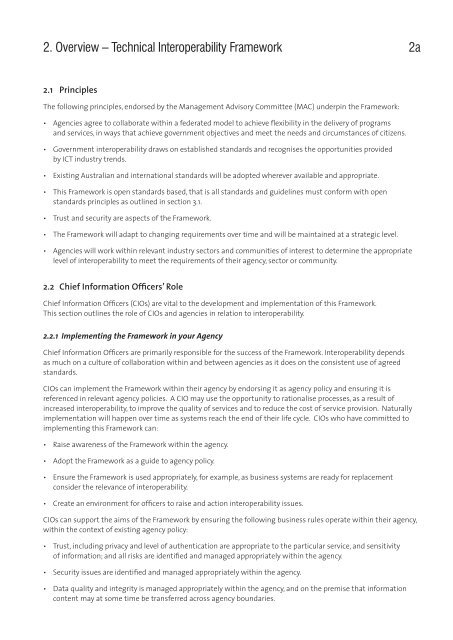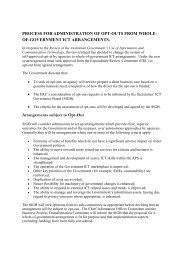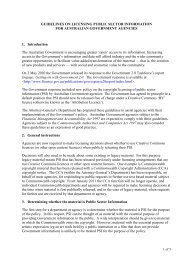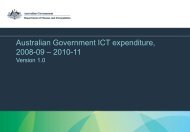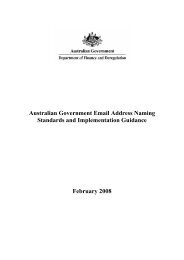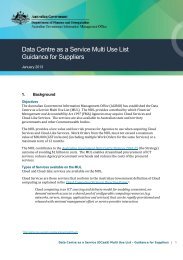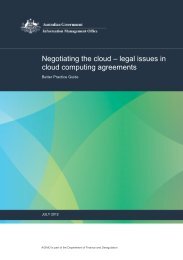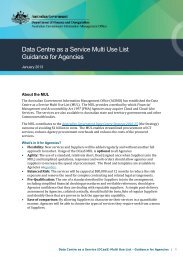Australian Government Technical Interoperability Framework
Australian Government Technical Interoperability Framework
Australian Government Technical Interoperability Framework
You also want an ePaper? Increase the reach of your titles
YUMPU automatically turns print PDFs into web optimized ePapers that Google loves.
2. Overview – <strong>Technical</strong> <strong>Interoperability</strong> <strong>Framework</strong>2a2.1 PrinciplesThe following principles, endorsed by the Management Advisory Committee (MAC) underpin the <strong>Framework</strong>:• Agencies agree to collaborate within a federated model to achieve flexibility in the delivery of programsand services, in ways that achieve government objectives and meet the needs and circumstances of citizens.• <strong>Government</strong> interoperability draws on established standards and recognises the opportunities providedby ICT industry trends.• Existing <strong>Australian</strong> and international standards will be adopted wherever available and appropriate.• This <strong>Framework</strong> is open standards based, that is all standards and guidelines must conform with openstandards principles as outlined in section 3.1.• Trust and security are aspects of the <strong>Framework</strong>.• The <strong>Framework</strong> will adapt to changing requirements over time and will be maintained at a strategic level.• Agencies will work within relevant industry sectors and communities of interest to determine the appropriatelevel of interoperability to meet the requirements of their agency, sector or community.2.2 Chief Information Officers’ RoleChief Information Officers (CIOs) are vital to the development and implementation of this <strong>Framework</strong>.This section outlines the role of CIOs and agencies in relation to interoperability.2.2.1 Implementing the <strong>Framework</strong> in your AgencyChief Information Officers are primarily responsible for the success of the <strong>Framework</strong>. <strong>Interoperability</strong> dependsas much on a culture of collaboration within and between agencies as it does on the consistent use of agreedstandards.CIOs can implement the <strong>Framework</strong> within their agency by endorsing it as agency policy and ensuring it isreferenced in relevant agency policies. A CIO may use the opportunity to rationalise processes, as a result ofincreased interoperability, to improve the quality of services and to reduce the cost of service provision. Naturallyimplementation will happen over time as systems reach the end of their life cycle. CIOs who have committed toimplementing this <strong>Framework</strong> can:• Raise awareness of the <strong>Framework</strong> within the agency.• Adopt the <strong>Framework</strong> as a guide to agency policy.• Ensure the <strong>Framework</strong> is used appropriately, for example, as business systems are ready for replacementconsider the relevance of interoperability.• Create an environment for officers to raise and action interoperability issues.CIOs can support the aims of the <strong>Framework</strong> by ensuring the following business rules operate within their agency,within the context of existing agency policy:• Trust, including privacy and level of authentication are appropriate to the particular service, and sensitivityof information; and all risks are identified and managed appropriately within the agency.• Security issues are identified and managed appropriately within the agency.• Data quality and integrity is managed appropriately within the agency, and on the premise that informationcontent may at some time be transferred across agency boundaries.


